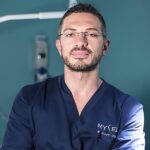Medical doctors and Surgeons
Calabrese: the importance of radiology in prevention
In the landscape of modern medicine, radiology plays a crucial role in the diagnosis, prevention, and treatment of various conditions, including breast cancer. This field focuses on obtaining and deciphering radiological images and is indispensable for monitoring various diseases, including tumours that require in-depth analysis to find the best therapy. Moreover, new innovations are making radiology useful not only in diagnosis but also in treatment.
Massimo Calabrese, an radiologist expert in senology at the San Martino Policlinico in Genoa and the president of the breast radiology section of the Italian Society of Medical Interventional Radiology, is the leading figure in this field. He is advancing innovative research and contributing to the growth of the discipline. In the interview, he explains how radiology can be decisive in cancer treatment.
The New Frontiers of Radiology
Breast cancer prevention is essential for ensuring good health and a higher quality of life. Radiological images are crucial in detecting tumours before they become too dangerous. «For example, breast tomosynthesis is a layered mammographic study of the breasts. It provides valuable additional information, especially after screening mammography».

Another recent technique is contrast-enhanced mammography, which can identify vascularized tumour masses, one of the indicators of malignant tumours. Previously, magnetic resonance imaging (MRI) of the breast was used, which was also effective but much more cumbersome. «MRI machines are very expensive. There aren’t that many available» explains Calabrese. «Every specialised physician’s office has a mammography machine, which is easier to manage and less expensive». Considering the incidence of breast cancer in the female population, the advantage of such an innovative technique is evident.
Finally, radiology is also showing promising results in therapy. «Small non-infiltrated tumours could be removed without scarring using vacuum-assisted breast biopsy» Calabrese states. This system is being studied alongside cryoablation. «It’s a system that uses probes to cool breast tissue to very low temperatures, allowing for tissue removal». These therapies will prove crucial in treating, for example, elderly patients who cannot undergo surgeries.
Radiology and Innovation: Towards Artificial Intelligence
«In medicine, if you don’t keep the possibility of studying, in six months, we are all old.» The early ageing that Calabrese refers to is technological. «In six months, technological growth is extremely rapid, especially for those involved in imaging technology like us; the growth is even more tumultuous.» For instance, think about what is digital: cell phones, computers, and software.
As in other sectors, even in radiology, the near future will see the contribution of something much more science fiction-like: artificial intelligence. «Those working with technology and imaging cannot help but understand the positives of AI» he explains. «There’s a massive amount of numerical data in images that we still can’t study, but very powerful computers can».
Of course, AI cannot replace radiologists, but it can support them in their work. «Artificial intelligence can do endless sums, but it can’t do what human intelligence does: bring together concepts studied, experienced, or validated at different times in life to turn them into useful information at the right moment».
The Importance of Education
Dr. Calabrese holds a significant role as the President of the Italian Society of Medical Interventional Radiology. This position entails tasks of great importance, such as professional updates for radiologists and the promotion of collaborations among various institutions and scientific societies. The goal is to keep specialists in breast radiology constantly updated on the latest developments and technologies, enabling them to provide the best possible treatment to patients.
This technological emphasis in radiology comes with the necessity of staying constantly updated. «We participate in writing and producing all the guidelines in our field and therefore, in my case, in areas related to senology, in addition to organising congresses and conferences» Calabrese concludes. A task of great responsibility that has a significant impact on the medical community and all the patients who will entrust these professionals with their care.




































